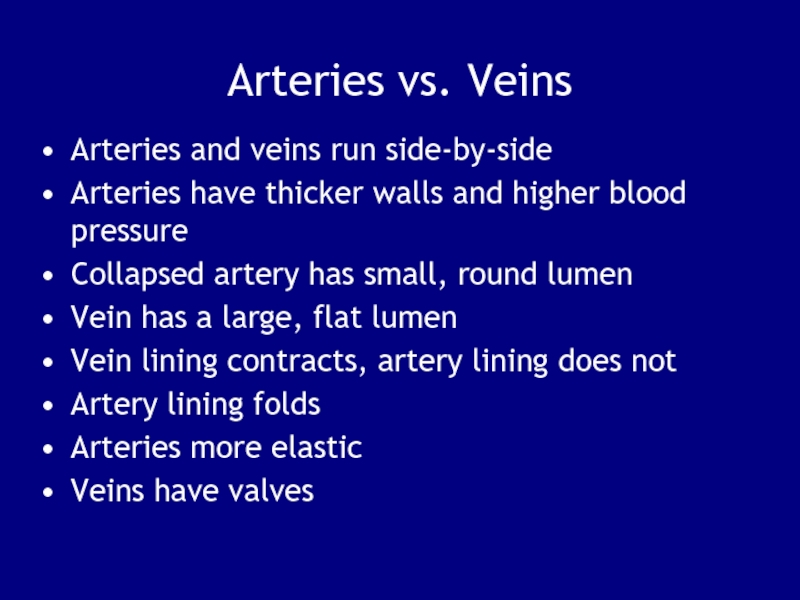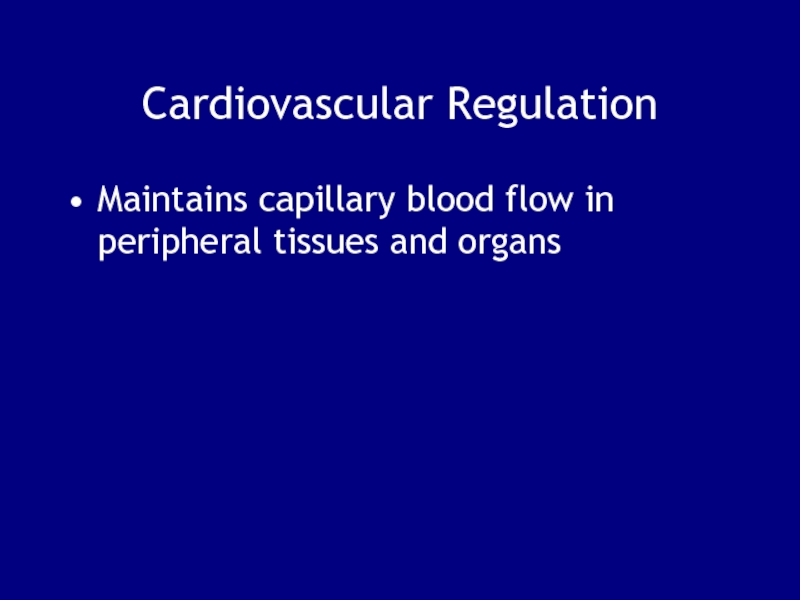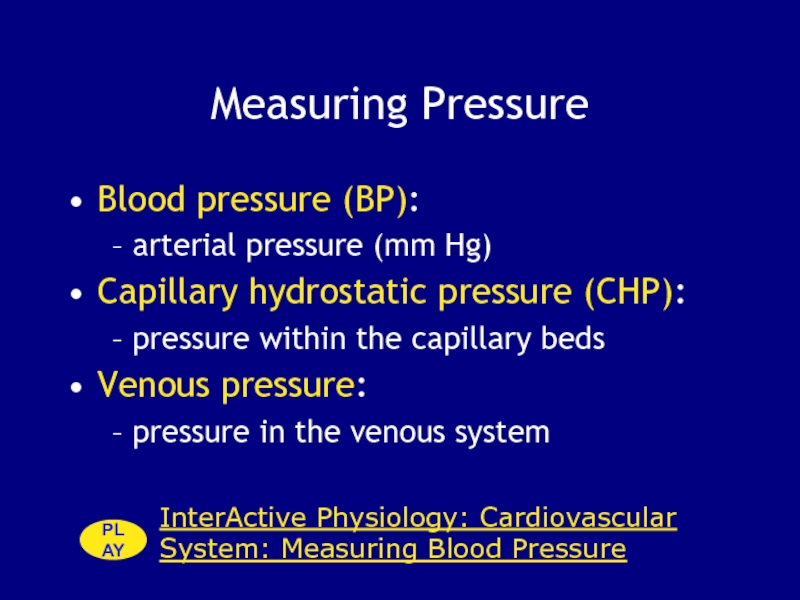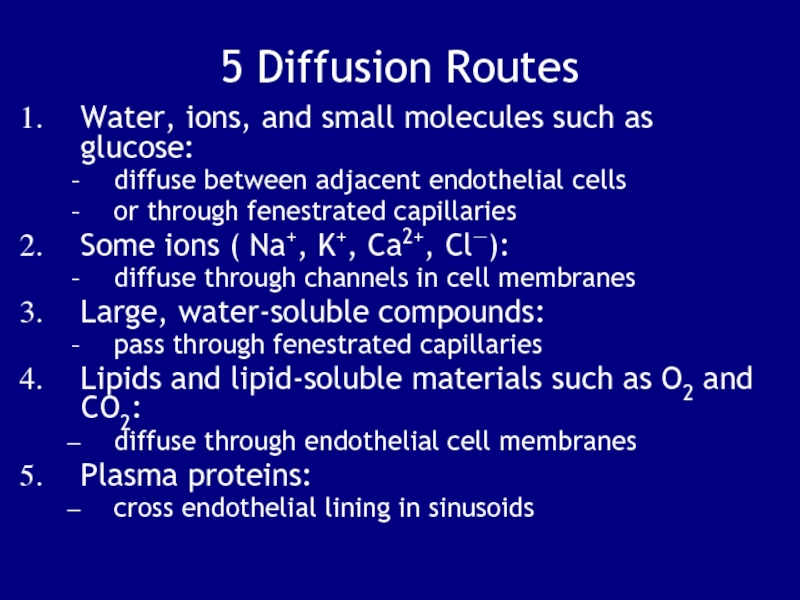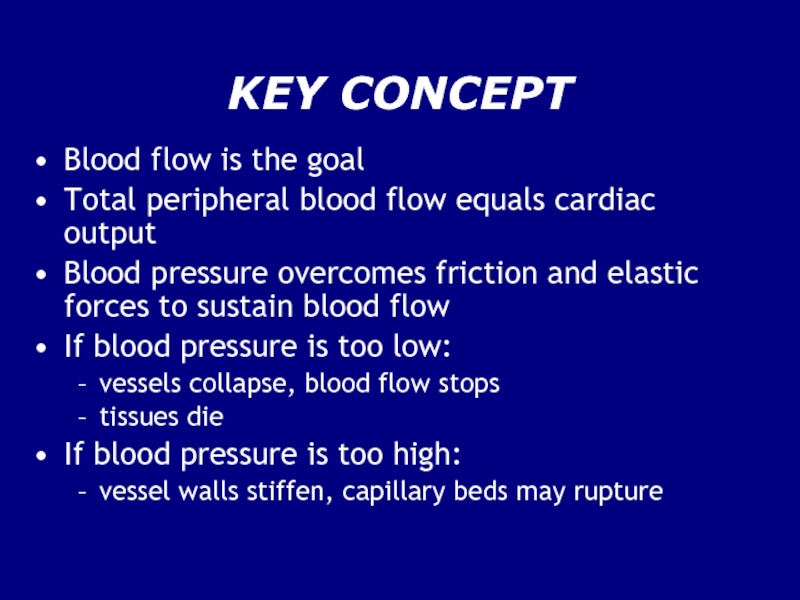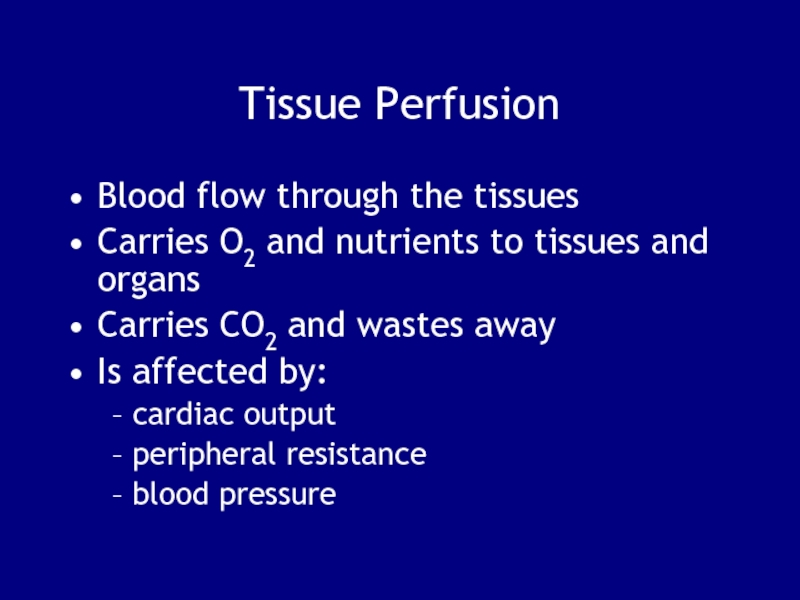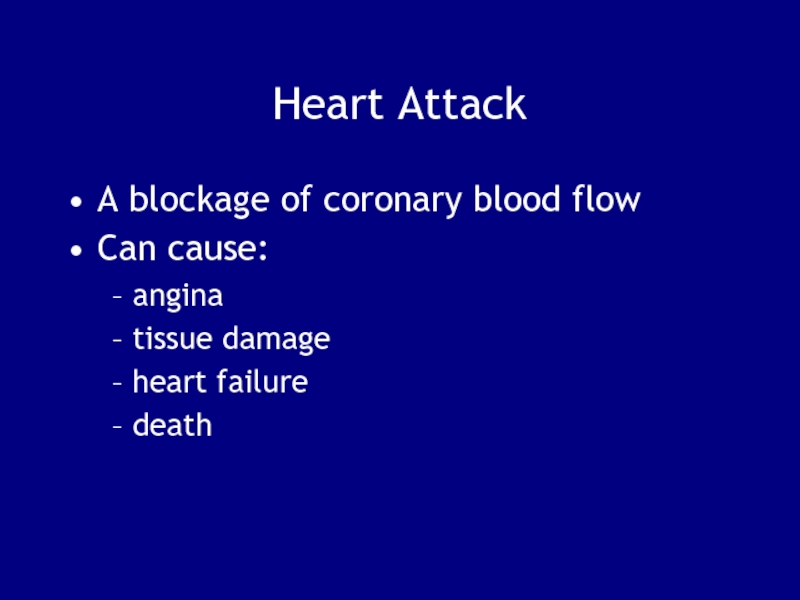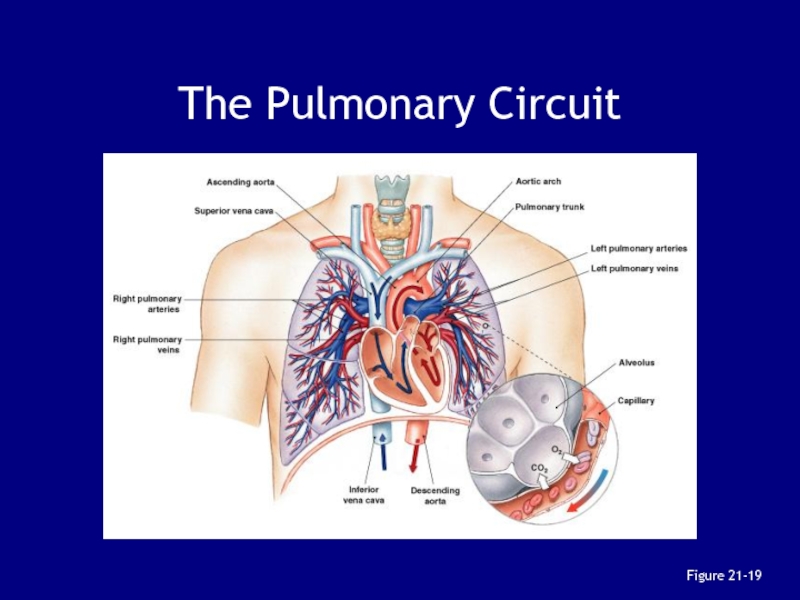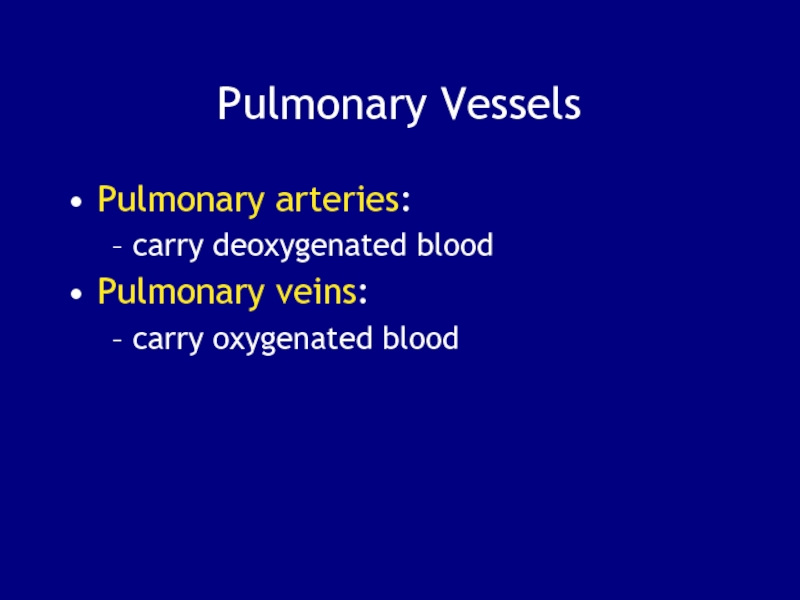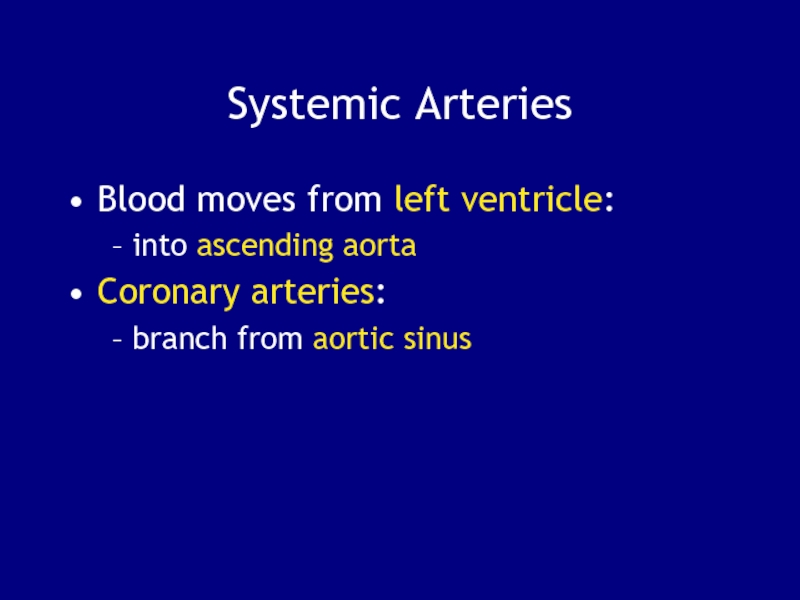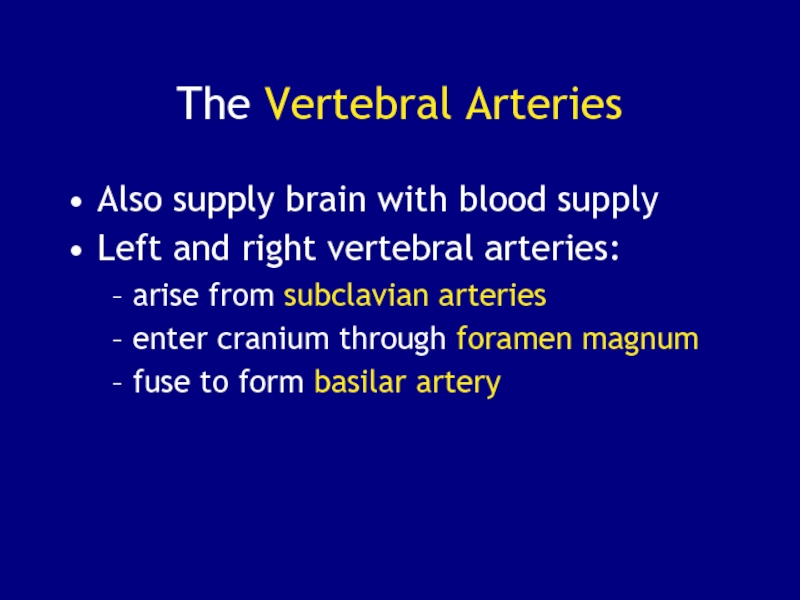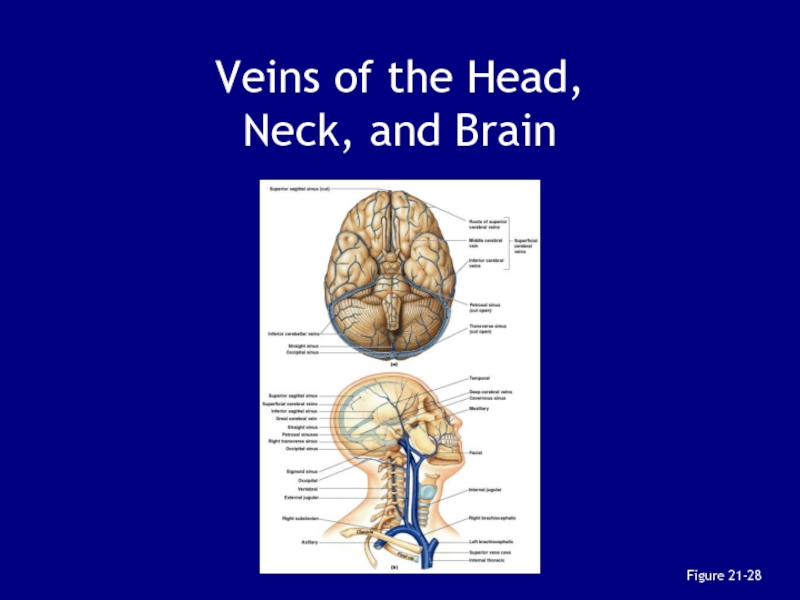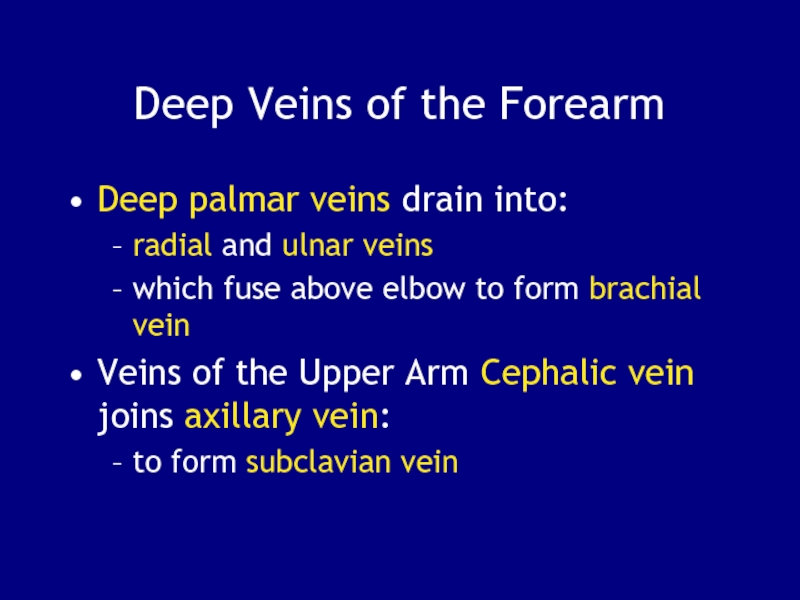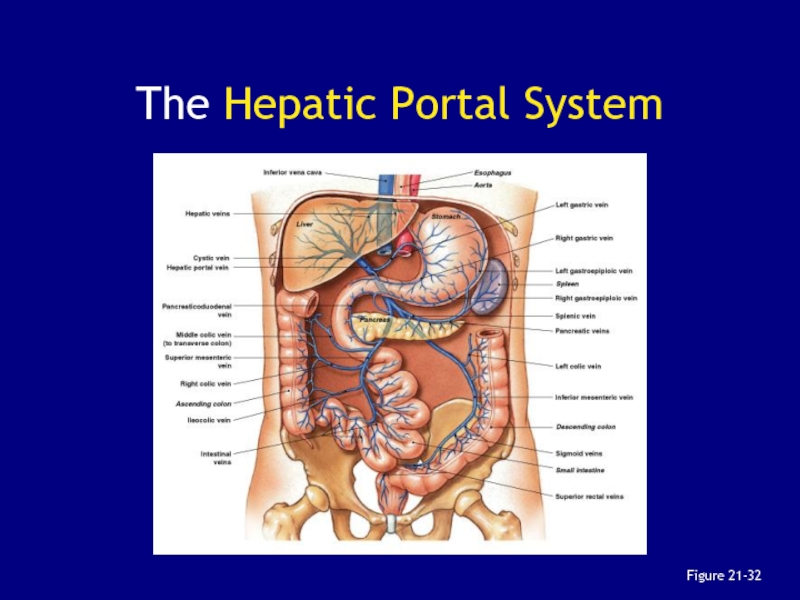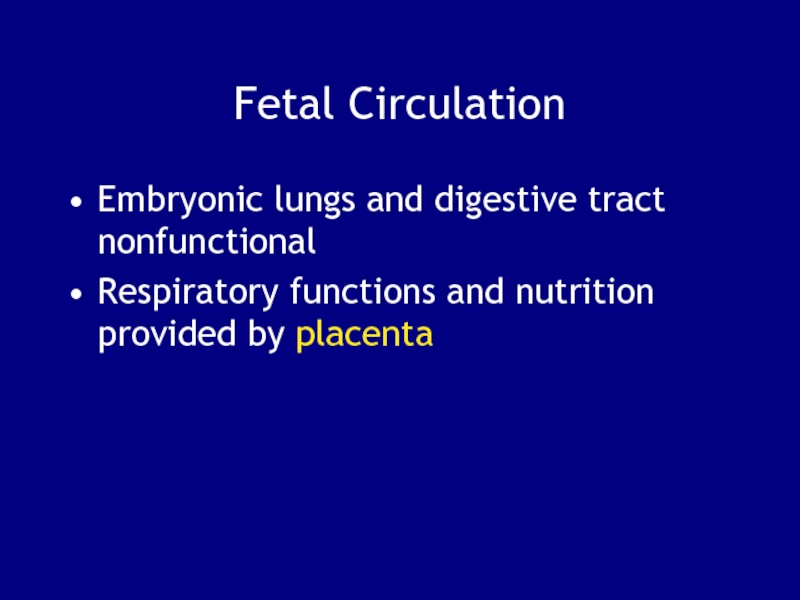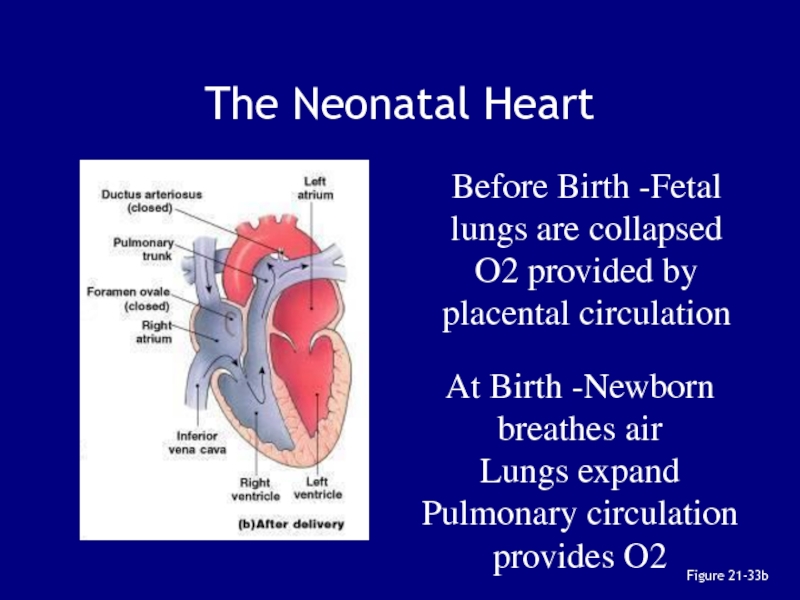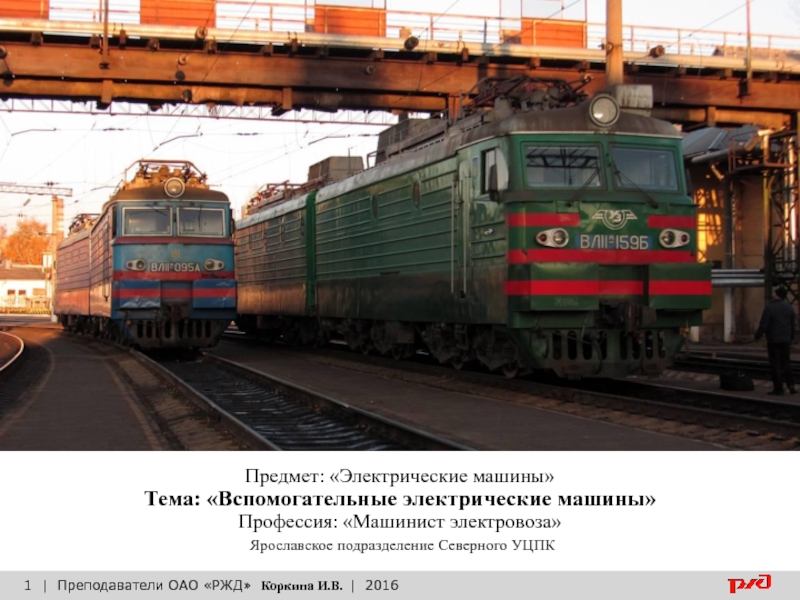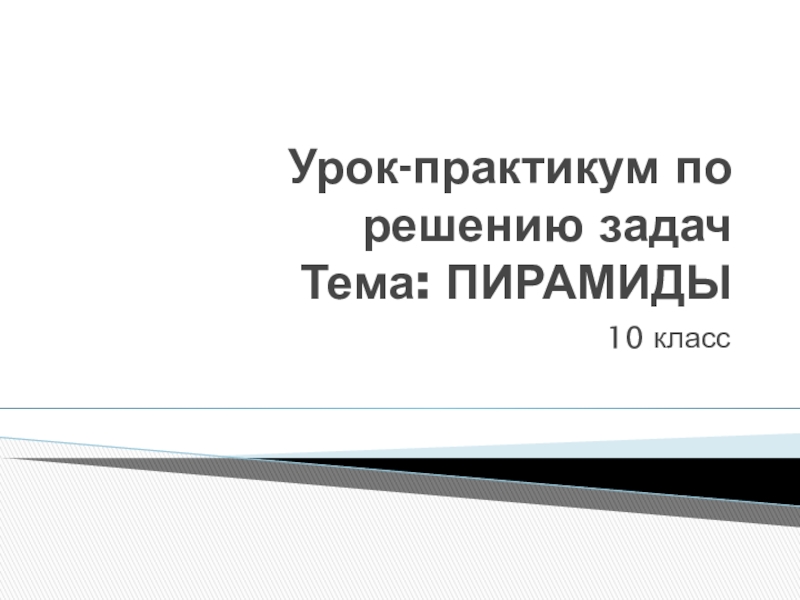Слайд 1Chapter 21:
Blood Vessels and Circulation
Biol141 A & P
R.L. Brashear-Kaulfers
Слайд 25 Classes of Blood Vessels
Arteries:
carry blood away from heart
Arterioles:
Are smallest
branches of arteries
Capillaries:
are smallest blood vessels
location of exchange between blood
and interstitial fluid
Venules:
collect blood from capillaries
Veins:
return blood to heart
Слайд 3The Largest Blood Vessels
Attach to heart
Pulmonary trunk:
carries blood from right
ventricle
to pulmonary circulation
Aorta:
carries blood from left ventricle
to systemic circulation
Слайд 4The Smallest Blood Vessels
Capillaries
Have small diameter and thin walls
Chemicals
and gases diffuse across walls
Слайд 5Structure of Vessel Walls
Figure 21-1
Tunica Externa
In arteries:
contain collagen
elastic fibers
In veins:
contain
elastic fibers
smooth muscle cells
Слайд 6Arteries vs. Veins
Arteries and veins run side-by-side
Arteries have thicker walls
and higher blood pressure
Collapsed artery has small, round lumen
Vein has
a large, flat lumen
Vein lining contracts, artery lining does not
Artery lining folds
Arteries more elastic
Veins have valves
Слайд 7Arteries and Pressure
Elasticity allows arteries to absorb pressure waves that
come with each heartbeat
Contractility -Arteries change diameter
Controlled by sympathetic division
of ANS
Слайд 8Vasoconstriction
and Vasodilation
Vasoconstriction -The contraction of arterial smooth muscle by
the ANS
Vasodilatation- The relaxation of arterial smooth muscle
Enlarging
the lumen
Both Affect:
afterload on heart
peripheral blood pressure
capillary blood flow
Слайд 9Structure of Blood Vessels
Figure 21-2
Artery Characteristics
From heart to capillaries, arteries
change:
from elastic arteries
to muscular arteries
to arterioles
Слайд 10Arterioles
Are small
Have little or no tunica externa
Have thin or
incomplete tunica media
Слайд 11Artery Diameter
Small muscular arteries and arterioles:
changes with sympathetic or endocrine
stimulation
constricted arteries oppose blood flow
Resistance (R) -The force opposing blood
flow
Resistance vessels:
arterioles
Слайд 12Aneurysm
A bulge in an arterial wall
Is caused by weak
spot in elastic fibers
Pressure may rupture vessel
Слайд 13Capillaries
Are smallest vessels with thin walls
Microscopic capillary networks permeate all
active tissues
Capillary Function
Location of all exchange functions of
cardiovascular system
Materials diffuse between blood and interstitial fluid
Слайд 152 Types of Capillaries
1. Continuous capillaries-Have complete endothelial lining
Are found in all tissues except epithelia and cartilage
Permit
diffusion of:
Water, small solutes, Lipid-soluble materials
Block:
blood cells, plasma proteins
Are in CNS and thymus, Have very restricted permeability e.g., the blood–brain barrier
2. Fenestrated capillaries-Have complete endothelial lining
Are found in all tissues except epithelia and cartilage, in choroid plexus, endocrine organs, kidneys,intestinal tract
Слайд 16Capillary Networks
Figure 21-5
Capillary bed or capillary plexus
Connect 1 arteriole and
1 venule
Слайд 17Capillary Sphincter
Guards entrance to each capillary
Opens and closes,
causing capillary blood to flow in pulses
Vasomotion -Contraction and relaxation
cycle of capillary sphincters
Causes blood flow in capillary beds to constantly change routes
Слайд 18Veins
Collect blood from capillaries in tissues and organs
Return blood to
heart
Veins vs. Arteries
Are
larger in diameter
Have thinner walls
Carry lower blood pressure
Слайд 193 Vein Categories
Venules:
very small veins
collect blood from capillaries
Medium-sized veins:
thin tunica
media and few smooth muscle cells
tunica externa with longitudinal bundles
of elastic fibers
Large veins:
have all 3 tunica layers
thick tunica externa
thin tunica media
Слайд 20Valves in the Venous System
Figure 21-6
Vein Valves
Folds of tunica intima
Prevent blood from flowing backward
Compression pushes blood toward heart
Слайд 21Figure 21-7
Blood Distribution
Heart, arteries, and capillaries:
30–35% of blood volume
Venous system:
60–65%
Слайд 22Venous Blood Distribution
1/3 of venous blood is in the large
venous networks of the liver, bone marrow, and skin
Слайд 23Cardiovascular Physiology
Figure 21-8
Слайд 24Cardiovascular Regulation
Maintains capillary blood flow in peripheral tissues and organs
Слайд 25Capillary Blood Flow
Equals cardiac output
Is determined by:
pressure and resistance
in the cardiovascular system
Слайд 26InterActive Physiology: Cardiovascular System: Measuring Blood Pressure
PLAY
Measuring Pressure
Blood pressure (BP):
arterial
pressure (mm Hg)
Capillary hydrostatic pressure (CHP):
pressure within the capillary
beds
Venous pressure:
pressure in the venous system
Слайд 27Viscosity
R caused by molecules and suspended materials in a
liquid
Whole blood viscosity is about 4 times that of water
Слайд 28Turbulence
Swirling action that disturbs smooth flow of liquid
Occurs in
heart chambers and great vessels
Atherosclerotic plaques cause abnormal turbulence
Слайд 29Pressures in the
Systemic Circuit
Systolic pressure:
peak arterial pressure during ventricular
systole
Diastolic pressure:
minimum arterial pressure during diastole
Pulse pressure:
difference between systolic
pressure and diastolic pressure
Mean arterial pressure (MAP):
MAP = diastolic pressure + 1/3 pulse pressure
Слайд 30Abnormal Blood Pressure
Hypertension:
abnormally high blood pressure:
greater than 140/90
Hypotension:
abnormally low
blood pressure
Слайд 31Venous Return
Amount of blood arriving at right atrium each minute
Determined
by venous pressure
Low effective pressure in venous system
Low venous
resistance Is assisted by:
muscular compression of peripheral veins
the respiratory pump
Compression of skeletal muscles:
pushes blood toward heart (one-way valves)
Слайд 32Capillary Exchange
Vital to homeostasis
Moves materials across capillary walls by:
diffusion, filtration,
and reabsorption
Слайд 335 Diffusion Routes
Water, ions, and small molecules such as glucose:
diffuse
between adjacent endothelial cells
or through fenestrated capillaries
Some ions ( Na+,
K+, Ca2+, Cl—):
diffuse through channels in cell membranes
Large, water-soluble compounds:
pass through fenestrated capillaries
Lipids and lipid-soluble materials such as O2 and CO2:
diffuse through endothelial cell membranes
Plasma proteins:
cross endothelial lining in sinusoids
Слайд 34Figure 21-11
Capillary Filtration
Слайд 35Capillary Exchange
At arterial end of capillary:
fluid moves out of capillary
into
interstitial fluid
At venous end of capillary:
fluid moves into capillary
out of
interstitial fluid
Слайд 36The Transition Point
Between filtration and reabsorption
is closer to venous
end than arterial end
Capillaries filter more than reabsorb
Excess fluid
enters lymphatic vessels
Слайд 374 Functions of
Blood and Lymph Cycle
Ensures constant plasma and
interstitial fluid communication
Accelerates distribution of nutrients, hormones, and dissolves gases
through tissues
Transports insoluble lipids and tissue proteins that can’t cross capillary walls
Flushes bacterial toxins and chemicals to immune system tissues
Слайд 38Capillary Dynamics
Hemorrhaging:
reduces CHP and NFP
increases reabsorption of interstitial fluid (recall
of fluids)
Dehydration:
increases BCOP
accelerates reabsorption
Increase in CHP or BCOP:
fluid moves out
of blood
builds up in peripheral tissues (edema)
Слайд 39KEY CONCEPT
Blood flow is the goal
Total peripheral blood flow equals
cardiac output
Blood pressure overcomes friction and elastic forces to sustain
blood flow
If blood pressure is too low:
vessels collapse, blood flow stops
tissues die
If blood pressure is too high:
vessel walls stiffen, capillary beds may rupture
Слайд 40How do central and
local control mechanisms interact to regulate
blood
flow and pressure in tissues?
Слайд 41Tissue Perfusion
Blood flow through the tissues
Carries O2 and nutrients
to tissues and organs
Carries CO2 and wastes away
Is affected by:
cardiac
output
peripheral resistance
blood pressure
Слайд 423 Regulatory Mechanisms
Control cardiac output and blood pressure:
1. Autoregulation:
causes immediate,
localized homeostatic adjustments
Neural mechanisms:
respond quickly to changes at specific sites
3. Endocrine
mechanisms:
direct long-term changes
Слайд 43Vasodilators
Dilate precapillary sphincters
Local vasodilators:
accelerate blood flow at tissue level
Low
O2 or high CO2 levels
Low pH (acids),Nitric oxide (NO)
High K+
or H+ concentrations
Chemicals released by inflammation (histamine)
Elevated local temperature
Слайд 44Patterns of
Cardiovascular Response
Blood, heart, and cardiovascular system:
work together as
unit
respond to physical and physiological changes (e.g., exercise, blood loss)
to maintain homeostasis
Слайд 45Table 21-2
Blood Distribution
during Exercise
Слайд 463 Effects of Light Exercise
Extensive vasodilation occurs:
increasing circulation
Venous return
increases:
with muscle contractions
Cardiac output rises:
due to rise in venous return
(Frank–Starling principle) and atrial stretching
Слайд 475 Effects of Heavy Exercise
Activates sympathetic nervous system
Cardiac output
increases to maximum:
about 4 times resting level
Restricts blood flow
to “nonessential” organs (e.g., digestive system)
Redirects blood flow to skeletal muscles, lungs, and heart
Blood supply to brain is unaffected
Слайд 48Table 21-3
Training and
Cardiovascular Performance
Effects of Exercise
Regular moderate exercise:
lowers total
blood cholesterol levels
Intense exercise:
can cause severe physiological stress
Слайд 49Figure 21-17
Responses to Blood Loss
Слайд 50Responses to Severe Blood Loss
Also called hemorrhaging
Entire cardiovascular system adjusts
to:
maintain blood pressure
restore blood volume
To prevent drop in blood
pressure:
1. carotid and aortic reflexes:
increase cardiac output (increasing heart rate)
cause peripheral vasoconstriction
Sympathetic nervous system:
triggers hypothalamus
further constricts arterioles
venoconstriction improves venous return
Слайд 513 Short-Term
Responses to Hemorrhage
To prevent drop in blood pressure:
1. carotid
and aortic reflexes:
increase cardiac output (increasing heart rate)
cause peripheral vasoconstriction
2.
Sympathetic nervous system:
triggers hypothalamus
further constricts arterioles
venoconstriction improves venous return
3. Hormonal effects:
increase cardiac output
increase peripheral vasoconstriction (E, NE, ADH, angiotensin II)
Слайд 52Shock
Short-term responses compensate up to 20% loss of blood volume
Failure
to restore blood pressure results in shock
Circulatory Shock
PLAY
Слайд 534 Long-Term
Responses to Hemorrhage
Restoration of blood volume can take
several days:
Recall of fluids from interstitial spaces
2. Aldosterone and ADH promote
fluid retention and reabsorption
3. Thirst increases
4. Erythropoietin stimulates red blood cell production
Слайд 54What are the principle
blood vessels and functional characteristics of
the
special circulation to the brain, heart, and lungs?
Слайд 55Blood Flow to the Brain
Is top priority
Brain has high oxygen
demand
When peripheral vessel constrict, cerebral vessels dilate, normalizing blood flow
Слайд 56Stroke
Also called cerebrovascular accident (CVA)
Blockage or rupture in a
cerebral artery
Stops blood flow
Слайд 57Blood Flow to the Heart
Through coronary arteries
Oxygen demand increases
with activity
Lactic acid and low O2 levels:
dilate coronary vessels
increase coronary
blood flow
Epinephrine:
dilates coronary vessels
increases heart rate
strengthens contractions
Слайд 58Heart Attack
A blockage of coronary blood flow
Can cause:
angina
tissue damage
heart failure
death
Слайд 59Blood Flow to the Lungs
Regulated by O2 levels in
alveoli
High O2 content:
vessels dilate
Low O2 content:
vessels constrict
Pulmonary Blood
Pressure :
In pulmonary capillaries:
is low to encourage reabsorption
If capillary pressure rises:
pulmonary edema occurs
Слайд 60Figure 21-18
Circulation Patterns
3 Distribution Patterns:
1. Peripheral artery and vein distribution:
is
the same on right and left, except near the heart
2.
The same vessel: may have different names in different locations
3. Tissues and organs usually have multiple arteries and veins:
vessels may be interconnected by anastomoses
Слайд 61Figure 21-19
The Pulmonary Circuit
Слайд 62The Pulmonary Circuit
Deoxygenated blood arrives at heart from systemic circuit:
passes
through right atrium and ventricle
enters pulmonary trunk
At the lungs:
CO2
is removed
O2 is added
Oxygenated blood:
returns to the heart
is distributed to systemic circuit
Слайд 63Pulmonary Vessels
Pulmonary arteries:
carry deoxygenated blood
Pulmonary veins:
carry oxygenated blood
Слайд 64Pulmonary Arteries
Pulmonary trunk:
branches to left and right pulmonary arteries
Pulmonary
arteries:
branch into pulmonary arterioles
Pulmonary arterioles:
branch into capillary networks that
surround alveoli
Слайд 65Pulmonary Veins
Capillary networks around alveoli:
join to form venules
Venules:
join to form
4 pulmonary veins
Pulmonary veins:
empty into left atrium
Слайд 66Figure 21-20
Major Systemic Arteries
The Systemic Circuit
Contains 84% of blood volume
Supplies
entire body:
except for pulmonary circuit
Слайд 673D Peel-Away of Arteries
of the Upper Limbs
PLAY
Figure 21-21a, b
Arteries
of the Chest
and Upper Limbs
Слайд 68Systemic Arteries
Blood moves from left ventricle:
into ascending aorta
Coronary arteries:
branch from
aortic sinus
Слайд 69The Aorta
The ascending aorta:
rises from the left ventricle
curves to form
aortic arch
turns downward to become descending aorta
Branches of the Aortic
Arch deliver blood to head and neck:
brachiocephalic trunk
left common carotid artery
left subclavian artery
Слайд 70The Brachiocephalic Trunk Branches to form:
right subclavian artery
right common
carotid artery
The Subclavian Arteries Branches within thoracic cavity:
internal thoracic artery
vertebral
artery
thyrocervical trunk
Слайд 71The Subclavian Arteries
The Subclavian Arteries Branches within thoracic cavity:
internal
thoracic artery
vertebral artery
thyrocervical trunk
Leaving the thoracic cavity:
become axillary artery in
arm
and brachial artery distally- Divides at coronoid fossa of humerus:
into radial artery and ulnar artery
Слайд 72Arteries of the Neck and Head
3D Peel-Away of Arteries of
the Head and Neck
PLAY
Figure 21-22
Слайд 73The Common Carotid Arteries
Carry blood to head and neck
Each
common carotid divides into:
external carotid artery-Supplies structures of: Neck, lower
jaw, face
internal carotid artery-Enters skull and divides into: opthalmic artery, anterior cerebral artery, middle cerebral artery
Слайд 74Figure 21-23
Arteries of the Brain
Слайд 75The Vertebral Arteries
Also supply brain with blood supply
Left and
right vertebral arteries:
arise from subclavian arteries
enter cranium through foramen magnum
fuse
to form basilar artery
Слайд 76Figure 21-24a
Arteries of the Trunk
Descending Aorta - is divided by
diaphragm into:
thoracic aorta
abdominal aorta
Слайд 77Figure 21-24b
Arteries of the Trunk
3D Peel-Away of Arteries of the
Trunk
PLAY
Thoracic Aorta branches are anatomically grouped into:
visceral
parietal
Слайд 784 Visceral Branches
Supply organs of the chest:
bronchial arteries
pericardial arteries
esophogeal
arteries
mediastinal arteries
Слайд 79The Abdominal Aorta
Divides at terminal segment of the aorta
into:
left common iliac artery
right common iliac artery
Слайд 80Branches of the Abdominal Aorta
Unpaired branches:
major branches to visceral organs
Paired
branches:
to body wall
kidneys
urinary bladder
structures outside abdominopelvic cavity
Слайд 81Figure 21-25
Arteries of the
Abdominopelvic Organs
Слайд 823 Unpaired Branches
of the Abdominal Aorta
Celiac trunk, divides
into:
left gastric artery
splenic artery
common hepatic artery
Superior mesenteric artery
Left mesenteric artery
Слайд 835 Paired Branches of
the Abdominal Aorta
Inferior phrenic arteries
Suprarenal
arteries
Renal arteries
Gonadal arteries
Lumbar arteries
Слайд 84The Abdominal Aorta
Divides to form:
right and left common iliac
arteries – Divide to form: internal iliac artery, external
iliac artery
middle sacral artery-
Слайд 853D Peel-Away of Arteries
of the Lower Limbs
PLAY
Figure 21-26
Arteries of
the Lower Limbs
Слайд 86Figure 21-27
Major Systemic Veins
All Systemic Veins
Drain into either:
superior vena cava
(SVC)
or inferior vena cava (IVC)
Слайд 87Complementary
Arteries and Veins
Run side by side
Branching patterns of peripheral
veins are more variable
Слайд 88Differences in Artery
and Vein Distribution
In neck and limbs:
1 set
of arteries (deep)
2 sets of veins (1 deep, 1 superficial)
Venous
system controls body temperature
Слайд 89Figure 21-28
Veins of the Head,
Neck, and Brain
Слайд 90The Superior Vena Cava (SVC)
Receives blood from:
head
neck
chest
shoulders
upper limbs
Слайд 91Veins of the Neck
Temporal and maxillary veins:
drain to external jugular
vein
Facial vein:
drains to internal jugular vein
Слайд 92Figure 21-29
Veins of the Abdomen and Chest
Слайд 93Deep Veins of the Forearm
Deep palmar veins drain into:
radial and
ulnar veins
which fuse above elbow to form brachial vein
Veins of
the Upper Arm Cephalic vein joins axillary vein:
to form subclavian vein
Слайд 94The Subclavian Vein
Merges with external and internal jugular veins:
to form brachiocephalic vein
which enters thoracic cavity
Слайд 95Veins of the Thoracic Cavity
Brachiocephalic vein receives blood from:
vertebral vein
internal thoracic vein
Merge to form the
superior vena cava (SVC)
Слайд 96Figure 21-30a
Tributaries of the
Superior Vena Cava
Слайд 97Figure 21-30b
Tributaries of the
Inferior Vena Cava
Inferior Vena Cava collects
blood from organs inferior to the diaphragm
Слайд 98Figure 21-31
Veins of the Lower Limbs
Слайд 99The Femoral Vein
Before entering abdominal wall, receives blood from:
great
saphenous vein
deep femoral vein
femoral circumflex vein
Inside the pelvic cavity:
becomes the
external iliac vein
The Right and Left Common Iliac Veins Merge to form the inferior vena cava
Слайд 100Figure 21-29
Veins of the Abdomen
6 Major Tributaries of the Abdominal
Inferior Vena Cava:
Lumbar veins
Gonadal veins
Hepatic veins
Renal veins
Suprarenal veins
Phrenic veins
Слайд 101Figure 21-32
The Hepatic Portal System
Слайд 102The Hepatic Portal System
Connects 2 capillary beds
Delivers nutrient-laden blood:
from
capillaries of digestive organs
to liver sinusoids for processing
Слайд 1035 Tributaries of the
Hepatic Portal Vein
Inferior mesenteric vein:
drains
part of large intestine
Splenic vein:
drains spleen, part of stomach, and
pancreas
Superior mesenteric vein:
drains part of stomach, small intestine, and part of large intestine
Left and right gastric veins:
drains part of stomach
Cystic vein:
drains gallbladder
Слайд 104Blood Processed in Liver
After processing in liver sinusoids, blood collects
in hepatic veins and empties into inferior vena cava
Слайд 105Fetal Circulation
Embryonic lungs and digestive tract nonfunctional
Respiratory functions and nutrition
provided by placenta
Слайд 106Figure 21-33a
Placental Blood Supply
Blood flows to the placenta:
through a pair
of umbilical arteries
which arise from internal iliac arteries
and enter
umbilical cord
Blood returns from placenta:
in a single umbilical vein
which drains into ductus venosus
Ductus venosus:
empties into inferior vena cava
Слайд 107Figure 21-33b
The Neonatal Heart
Before Birth -Fetal lungs are collapsed
O2 provided
by placental circulation
At Birth -Newborn breathes air
Lungs expand
Pulmonary circulation
provides O2
Слайд 1082 Fetal Pulmonary
Circulation Bypasses
Foramen ovale:
interatrial opening
covered by
valve-like flap
directs blood from right to left atrium
Ductus arteriosus:
short
vessel
connects pulmonary and aortic trunks
Слайд 109Cardiovascular Changes at Birth
Pulmonary vessels expand
Reduced resistance allows blood flow
Rising
O2 causes ductus arteriosus constriction
Rising left atrium pressure closes foramen
ovale
Слайд 110Figure 21-34
Congenital
Cardiovascular Problems
Develop if proper circulatory changes do not
occur at birth
Слайд 111Aging and the
Cardiovascular System
Cardiovascular capabilities decline with age
Age-related changes
occur in:
blood
heart
blood vessels
Слайд 1123 Age-Related Changes in Blood
Decreased hematocrit
Blood clots (thrombus)
Blood-pooling in legs
due to venous valve deterioration
Слайд 1135 Age-Related
Changes in the Heart
Reduced maximum cardiac output
Changes
in nodal and conducting cells
Reduced elasticity of fibrous skeleton
Progressive atherosclerosis
Replacement
of damaged cardiac muscle cells by scar tissue
Слайд 1143 Age-Related
Changes in Blood Vessels
Arteries become less elastic:
pressure change
can cause aneurysm
Calcium deposits on vessel walls:
can cause stroke or
infarction
Thrombi can form:
at atherosclerotic plaques
Слайд 115Figure 21-35
Integration with Other Systems
Слайд 116Clinical Patterns
There are many categories of cardiovascular disorders
Disorders may:
affect all
cells and systems
be structural or functional
result from disease or trauma
Слайд 117SUMMARY (1)
3 types of blood vessels:
arteries
veins
Capillaries
Structure of vessel walls
Differences
between arteries and veins
Atherosclerosis, arteriosclerosis, and plaques
Structures of:
elastic arteries
muscular arteries
arterioles
Слайд 118SUMMARY (2)
Structures of capillary walls:
continuous
Fenestrated
Structures of capillary beds:
precapillary sphincters
vasomotion
arteriovenous
anastomoses
Functions of the venous system and valves
Distribution of blood and
venous reserves
Слайд 119SUMMARY (3)
Circulatory pressures:
blood pressure
capillary hydrostatic pressure
venous pressure
Resistance in blood vessels:
viscosity
turbulence
Vasoconstriction
The
respiratory pump
Capillary pressure and capillary exchange:
osmotic pressure
net filtration
pressure
Слайд 120SUMMARY (4)
Physiological controls of cardiovascular system:
Autoregulation, neural controls
hormonal controls
Cardiovascular
responses to exercise and blood loss
Special circulation to brain, heart,
and lungs
Distribution of arteries in pulmonary and systemic circuits
Distribution of veins in pulmonary and systemic circuits
Fetal circulation and changes at birth
Effects of aging on the cardiovascular system





